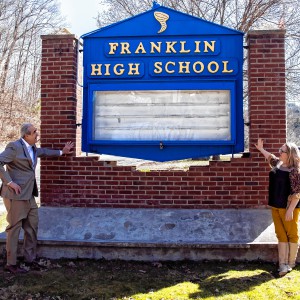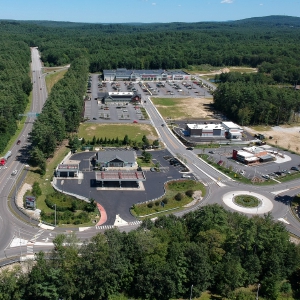At least six trees in Concord are the biggest of their kind in the whole state
| Published: 04-27-2018 9:22 AM |
It turns out Concord has something to brag about on Arbor Day when it comes to trees: Within the city limits, at least six trees qualify as the biggest of their species in all of New Hampshire.
That includes the huge Norway maple next to the arch in front of the State House, as well as a dogwood, a slippery elm, an osage-orange, an American smoketree and an American sycamore.
A seventh is likely, but not confirmed.
How is this known? Since 1950, volunteers have been going around New Hampshire and measuring trees, looking for the biggest example of each species.
Kevin Martin, the state coordinator of the New Hampshire Big Tree Program, figures he’s personally visited, measured and inspected 300 big trees, some of which have turned out to be champions.
“It’s pretty exciting when you get a champ, especially a national champion, which are few and far between in New Hampshire,” he said.
Four communities rise above all others for their concentration of big trees: Concord is at the top of the list along with Walpole, situated along the Connecticut River on the Vermont border, with seven state champion trees. Not far behind are Durham and Portsmouth with five state champions apiece, including one national champion.
While those locations might seem to have little in common, from a big-tree perspective they do.
Article continues after...
Yesterday's Most Read Articles
 Regal Theater in Concord is closing Thursday
Regal Theater in Concord is closing Thursday
 Former Franklin High assistant principal Bill Athanas is making a gift to his former school
Former Franklin High assistant principal Bill Athanas is making a gift to his former school
 Another Chipotle coming to Concord
Another Chipotle coming to Concord
 Vandals key cars outside NHGOP event at Concord High; attendee carrying gun draws heat from school board
Vandals key cars outside NHGOP event at Concord High; attendee carrying gun draws heat from school board
 Phenix Hall, Christ the King food pantry, rail trail on Concord planning board’s agenda
Phenix Hall, Christ the King food pantry, rail trail on Concord planning board’s agenda
 On the Trail: New congressional candidate spotlights border, inflation, overseas conflicts
On the Trail: New congressional candidate spotlights border, inflation, overseas conflicts
Concord and Portsmouth are historic cities, Martin explained. When early residents built their estates in the city centers, they planted trees, many of which remained on private property and have become enormous through centuries of growth.
In the case of Walpole and Durham, it’s more likely that someone has grown fond of big trees, sought them out and nominated them. Some 40 trees in Walpole have been identified as possible state or county champions.
“Up in the North Country, no one’s really looking for them,” Martin said.
The volunteer big tree program, run by UNH Cooperative Extension, has expanded over time and now includes 62 species, some as well-known as maple and some as obscure as hop-hornbeam, plus multiple sub-species (is that a Norway maple, red maple, silver maple, sugar maple or striped maple?)
Records are kept for the biggest examples of each species found in each of the state’s 10 counties, as well as in the state as a whole.
In four of these cases – a mountain ash in Stewartstown, a pitch pine in Newbury, a bigtooth aspen in Madbury, and a horse chestnut in Portsmouth – New Hampshire has the biggest known example of a species in the entire nation.
Trees are awarded points based on a combination of their size of their trunk – the circumference as measured 4½ feet above the ground – plus their estimated height, plus the estimated spread of their crown at its widest point. The resulting figure is a rough measure of the amount of biomass in the tree above ground – its weight, so to speak.
Martin, a boat-builder by trade who used to look at trees primarily for the quality of their lumber, has put together a book on the big trees of the Granite State and he’s working on a new one about the big trees of northern New England, so he can highlight trees on public lands that people can go visit.
“It’s always great when you get out there and it’s really tall or really big around. Just standing next to it is pretty impressive,” Martin said.
Martin, who has volunteered for the big tree program for 10 years, has become somewhat smitten by the quest to locate and identify the biggest trees of their kind.
If Martin were a tree, he’d be a cedar, he said. While that might seem like an odd thing to say, it’s not to someone who loves trees, Martin explained. He uses cedar in many of the boats he builds. He likes the way it smells, and the way it grows in out of the way places. He’s even visited the state champion cedar – located by Lake Francis in Clarksville and marked with scratches from a bear claw.
The list maintained by the NH Big Tree program online indicates that Concord actually has seven trees that are the biggest of their species in the state. Martin said one of the reports – for the mockernut hickory, which he said is a notoriously difficult species to identify – has not been confirmed.
New Hampshire Big Tree volunteers meets bimonthly for program updates, measuring trips and sharing their discoveries and stories. For more information, or to volunteer, check the web page.
(David Brooks can be reached at 369-3313 or dbrooks@cmonitor.com or on Twitter @GraniteGeek.)


 With less than three months left, Concord Casino hasn’t found a buyer
With less than three months left, Concord Casino hasn’t found a buyer Kearsarge Middle School drone team headed to West Virginia competition
Kearsarge Middle School drone team headed to West Virginia competition Granite Geek: Forest streams are so pretty; too bad they’re such a pain to measure
Granite Geek: Forest streams are so pretty; too bad they’re such a pain to measure
